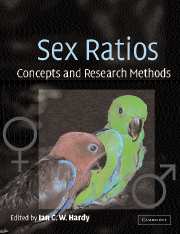Book contents
- Frontmatter
- Contents
- List of contributors
- Preface and acknowledgements
- Part 1 Sex ratio theory
- Part 2 Statistical analysis of sex ratio data
- Part 3 Genetics of sex ratio and sex determination
- Part 4 Animal sex ratios under different life-histories
- Part 5 Sex ratios in plants and protozoa
- Chapter 15 Sex ratios of malaria parasites and related protozoa
- Chapter 16 Sex allocation in hermaphrodite plants
- Chapter 17 Sex ratios in dioecious plants
- Part 6 Applications of sex ratios
- Index
- References
Chapter 15 - Sex ratios of malaria parasites and related protozoa
Published online by Cambridge University Press: 06 August 2009
- Frontmatter
- Contents
- List of contributors
- Preface and acknowledgements
- Part 1 Sex ratio theory
- Part 2 Statistical analysis of sex ratio data
- Part 3 Genetics of sex ratio and sex determination
- Part 4 Animal sex ratios under different life-histories
- Part 5 Sex ratios in plants and protozoa
- Chapter 15 Sex ratios of malaria parasites and related protozoa
- Chapter 16 Sex allocation in hermaphrodite plants
- Chapter 17 Sex ratios in dioecious plants
- Part 6 Applications of sex ratios
- Index
- References
Summary
Summary
We review methods for studying the adaptive basis of sex allocation in the phylum Apicomplexa, a group of parasitic protozoa that includes the aetiological agents of malaria. It is our contention that analysis of apicomplexan sex ratios is not only interesting in its own right, but may actually provide insights into matters of clinical and epidemiological importance. We begin by justifying that position, and then summarize the natural history of these parasites and the sex ratio expectations that flow from that. Broadly speaking, these expectations are supported, but the evidence is scanty relative to that for many multicelled taxa. In the second half of the chapter, we give an overview of the theoretical and empirical methods available to take this work further. Much remains to be done: many key assumptions are currently little more than acts of faith.
Introduction
Almost all work on the evolution of sex allocation is motivated by and tested on multicelled organisms. Yet the causative agents of some of the most serious diseases of humans and livestock have anisogamous sexual stages (Figure 15.1). These are all members of the protozoan phylum Apicomplexa, and include the malaria parasites (Plasmodium spp.). Species in other protozoan phyla can also have anisogamous sexual stages (e.g. some dinoflagellates, volvocidians and perhaps some foraminiferans; Lee et al. 1985) but we are unaware of any analysis of sex allocation in micro-organisms other than the Apicomplexa.
- Type
- Chapter
- Information
- Sex RatiosConcepts and Research Methods, pp. 314 - 332Publisher: Cambridge University PressPrint publication year: 2002
References
- 10
- Cited by



